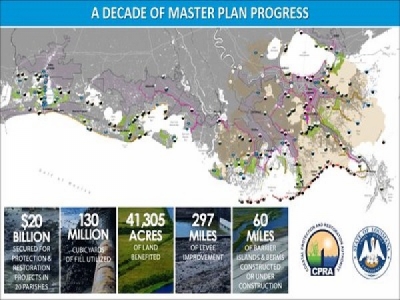
Posted on November 13, 2018
As Louisiana moves into an era of dramatically increased spending on coastal restoration projects – approaching $1 billion a year – the state’s leaders must remain guided by science and not politics, Gov. John Bel Edwards warned Wednesday (Nov. 7).
Speaking at a summit on the future of the state’s $50 billion, 50-year coastal master plan sponsored by the America’s WETLAND Foundation, Edwards said that with the movement towards construction of real projects on the ground, the days of the Legislature unanimously approving master plan updates, as it did in 2007, 2012 and 2017, are likely to be over.
“I expect that that’s going to be more difficult to do going forward because the master plan every day is less academic and theoretical and more real and translates into actions and investments,” Edwards said during a speech at the summit on the Louisiana State University campus. “So we need to be together. We need to work together to cooperate more now than ever in our past with respect to the master plan. “
Louisiana’s 2017 coastal master plan unanimously approved by state authority
He said the state continues to deal with the “trifecta” of threats to the state’s coastline: “sea level rise, subsidence and coastal erosion all at one time.”
But even though the severity of the threat is daunting – the worst-case scenario of land inundation contained in the 2012 master plan update became the moderate scenario that officials say is already occurring in the 2017 update – Edwards said it’s important for the state to get the message out that its restoration plan is on track to reduce that threat.
“It’s important to recognize the severity of the situation,” he said. “But it’s just as important to know, to believe and to communicate that we can and are taking the necessary steps to avoid the worst case scenarios, to minimize land loss. We truly are doing that.”
And as the state implements its plan, it must assure that project funding and decision-making are on track.
Part of that strategy includes moving beyond simply developing response and recovery plans in the aftermath of hurricane storm surge or rainfall disasters, he said.
“If we put that same effort into the mitigating the risk, we would save money over time and our people will be better for it,” Edwards said.
Indeed, he said, the state’s several decades of work on restoration already has it positioned to export its expertise to other coastal areas threatened by flooding in the U.S. and around the world.
Edwards’ lunchtime speech followed a sobering assessment of the threats of flooding to the way of life of residents of Houma, put forward by Keith Magill, executive editor of Houma Today.
Magill warned that residents of communities living outside the under-construction Morganza-to-the-Gulf hurricane levee that surrounds Houma are already moving out of small towns like Dulac, forced out by both repeated flooding and dramatic increases in the cost of flood insurance. Dulac lost 40 percent of its population between 2000 and 2010, according to Census records, he said.
In Houma, Magill said, residents have adopted an anxious wait-and-see attitude, waiting for state officials to identify as many as 8,000 residences in flood-prone areas that might be targeted for state buyouts or elevation grants in the future.
Jay Clune, who became president of Nicholls State University in January, said the university’s strategy is built around what he called a first class of adaptation survivors who have enrolled as students.
“In the worst case scenario, 80 percent of our student population would be under water,” he said.
But that’s why the school has doubled down on training this new generation of students with skills that can be used in the coastal restoration and hurricane surge protection effort. The school also has plans to increase its engineering courses, he said.
“We have more at stake than other universities in the state because we’re closest to the coast, 23 miles as the crow flies, 50 by car,” he said.
“Our students get it. They come here to save their homes,” he said. “We see that as our mission.”
America’s WETLAND also announced a new “Louisiana Coastal Exchange” initiative during the summit, aimed at developing an inventory of private sector coastal restoration projects that have been completed or are planned and available for private investment.
Source: nola





